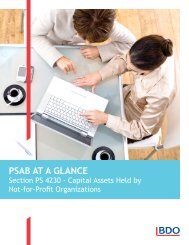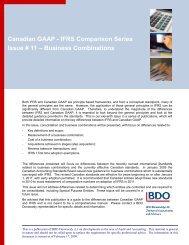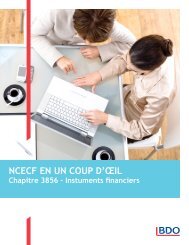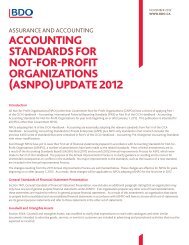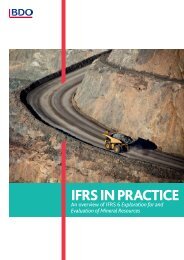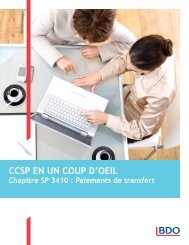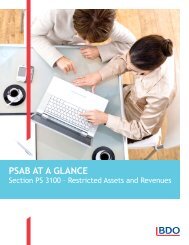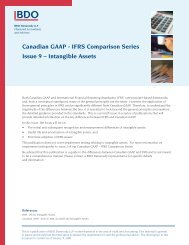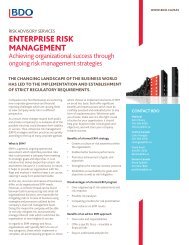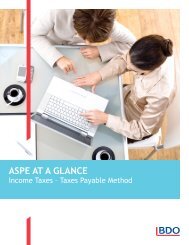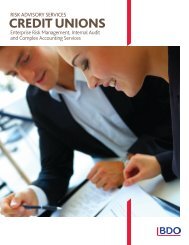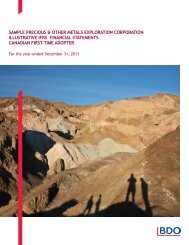Need to Know: IFRS 10 - Consolidated Financial ... - BDO Canada
Need to Know: IFRS 10 - Consolidated Financial ... - BDO Canada
Need to Know: IFRS 10 - Consolidated Financial ... - BDO Canada
- No tags were found...
Create successful ePaper yourself
Turn your PDF publications into a flip-book with our unique Google optimized e-Paper software.
46 <strong>IFRS</strong> <strong>10</strong> <strong>Consolidated</strong> <strong>Financial</strong> Statements8. Investment EntitiesOn 31 Oc<strong>to</strong>ber 2012 the International Accounting Standards Board (IASB) issued Investment Entities (Amendments <strong>to</strong> <strong>IFRS</strong> <strong>10</strong>,<strong>IFRS</strong> 12 and IAS 27(2011)) (the amendments) which introduces an exception <strong>to</strong> the principle that all subsidiaries are required <strong>to</strong>be consolidated.The amendments define an investment entity and require a parent that is an investment entity <strong>to</strong> measure its investmentsin particular subsidiaries at fair value through profit or loss in its consolidated and separate financial statements. They alsointroduce disclosure requirements for investment entities in<strong>to</strong> <strong>IFRS</strong> 12 Disclosure of Interests in Other Entities and amendIAS 27(2011) Separate <strong>Financial</strong> Statements.An investment entity is an entity whose business purpose is <strong>to</strong> make investments solely for capital appreciation, investmentincome, or both, and that evaluates the performance of those investments on a fair value basis. The IASB anticipates that themost common types of investment entity will be private equity organisations, venture capital organisations, pension funds,sovereign wealth funds and other investment funds.The amendments result from proposals in an Exposure Draft (the ED) published in August 2011. The project was undertakenjointly by the IASB and the US <strong>Financial</strong> Accounting Standards Board (FASB) (the boards) in the hope of achieving as similarguidance as possible. While the boards reached many common decisions, as a result of an initial scope difference, and otherjurisdictional differences, the boards came <strong>to</strong> different decisions in a number of areas.The ED proposed that in order <strong>to</strong> qualify as an investment entity, an entity would need <strong>to</strong> meet six specified criteria.These criteria were based on guidance in US GAAP. In response <strong>to</strong> the comments from respondents, including that thecriteria as drafted would inappropriately include or exclude various structures, the IASB decided <strong>to</strong> provide a definitionof an investment entity based on only some of the criteria originally proposed in the ED. The remaining criteria representtypical characteristics of an investment entity and have been included <strong>to</strong> help entities determine whether they qualify asan investment entity. If an entity does not display one or more of the typical characteristics, it indicates that additionaljudgement is required in determining whether the entity meets the definition of an investment entity. An entity that doesnot have one or more of the typical characteristics would be required <strong>to</strong> disclose how it still meets the definition of aninvestment entity.The ED also proposed <strong>to</strong> remove the fair value option from IAS 28(2011) Investment in Associates and Joint Ventures and<strong>to</strong> instead introduce a requirement for investment entities <strong>to</strong> measure their interests in joint ventures and associates atfair value through profit or loss. However IAS 28(2011) has not been amended and the fair value option for venture capitalorganisations, mutual funds, unit trusts and similar entities, including investment-linked insurance funds, has been retained.In retaining this option the IASB has noted that, <strong>to</strong> meet the definition of an investment entity, an entity must elect the fairvalue option in IAS 28(2011) for any investments in associates or joint ventures.



